 Fast forward to 2009 and a December 18th post by Swaraj Paul Barooach on the iconic SpicyIP Blog. Entitled "Liberalization of Foreign Technology Agreement Policy, the blog reported on the December 17 Press Release by the Government of India Press Note No. 8 (2009 series), which effectively provides that no longer will government approval of royalty payments be required above certain defined thresholds here. In short, the prior policy
Fast forward to 2009 and a December 18th post by Swaraj Paul Barooach on the iconic SpicyIP Blog. Entitled "Liberalization of Foreign Technology Agreement Policy, the blog reported on the December 17 Press Release by the Government of India Press Note No. 8 (2009 series), which effectively provides that no longer will government approval of royalty payments be required above certain defined thresholds here. In short, the prior policy "freely allowed payments and remittances up to a lump sum fee of $2 million and payment of royalty of 5% on domestic sales and 8% on experts. In addition, where there is no technology transfer involved, royalty up to 2% for exports and 1% for domestic sales ... on use of trade marks and brand names ...".Payments above these limits required the prior permission of the Government of India (Project Approval Board, Department of Industrial Policy and Promotion).
These limitations have now been scrapped, at least in material part. Lump sum payments and/or royalty payments for technology transfer or for the use of trade marks or brands no longer require Governmental approval, no matter, it appears, is the amount of the payment. There is one restriction, namely, the Foreign Exchange Management (Current Account Rules, 2000. What exactly are the contents of these rules is not further specified in the Press Release. As well, "[a] suitable post-reporting system for technology transfer/collaborations and use of trade mark/brand name will be notified by the Government separately."
There seem to be at least three related factors at work here. First, the amount of foreign direct investment (DFI) in India continues to increase apace (over $25 billion in 2008). At least a part of that DFI would also see to require collaboration agreements with foreign entities for the use of technology within India. As well, technology is increasingly licensed-in to India for the purpose of use and commercialization within the Indian national market. Restrictions on the amount of royalties that can be freely paid abroad would only serve to reduce the optimal use of this technology within India.
Second, there might be a connection between the new policy and the increasing liberalization of capital flows out of India. Think of Tata and its recent spate of acquisitions over the past several years. It would seem that such capital flows go hand in hand, at least conceptually, with the scrapping of approval requirements for royalty payments above a certain amount.
Third, much talk has made lately over the notion of reverse innovation, where India serves as the foundation for innovation, which is then transferred to the developed world: see here. It seems that if India is to benefit from royalty streams from abroad for the use of such fruits of reverse innovation, it behoves it to allow unfettered payments of royalties by Indian entities abroad.
All in all, the provisions as set out in the Press Release point to a liberal Indian market for tech transfer, something which could have even been dreamed in the 1980's.
